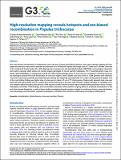Por favor, use este identificador para citar o enlazar a este item:
http://hdl.handle.net/10261/296376COMPARTIR / EXPORTAR:
 SHARE SHARE
 CORE
BASE CORE
BASE
|
|
| Visualizar otros formatos: MARC | Dublin Core | RDF | ORE | MODS | METS | DIDL | DATACITE | |

| Título: | High-resolution mapping reveals hotspots and sex-biased recombination in Populus trichocarpa |
Autor: | Abeyratne, Chanaka Roshan; Macaya-Sanz, David; Zhou, Ran; Barry, Kerrie W.; Daum, Christopher; Haiby, Kathy; Lipzen, Anna; Stanton, Brian; Yoshinaga, Yuko; Zane, Matthew; Tuskan, Gerald A.; DiFazio, Stephen Paul | Palabras clave: | Recombination Heterochiasmy Cross-over Sex-bias Populus |
Fecha de publicación: | 17-oct-2022 | Editor: | Oxford University Press | Citación: | G3 genes - genomes - genetics 13(1): ejkac269 (2023) | Resumen: | Fine-scale meiotic recombination is fundamental to the outcome of natural and artificial selection. Here, dense genetic mapping and haplotype reconstruction were used to estimate recombination for a full factorial Populus trichocarpa cross of 7 males and 7 females. Genomes of the resulting 49 full-sib families (N = 829 offspring) were resequenced, and high-fidelity biallelic SNP/INDELs and pedigree information were used to ascertain allelic phase and impute progeny genotypes to recover gametic haplotypes. The 14 parental genetic maps contained 1,820 SNP/INDELs on average that covered 376.7 Mb of physical length across 19 chromosomes. Comparison of parental and progeny haplotypes allowed fine-scale demarcation of cross-over regions, where 38,846 cross-over events in 1,658 gametes were observed. Cross-over events were positively associated with gene density and negatively associated with GC content and long-terminal repeats. One of the most striking findings was higher rates of cross-overs in males in 8 out of 19 chromosomes. Regions with elevated male cross-over rates had lower gene density and GC content than windows showing no sex bias. High-resolution analysis identified 67 candidate cross-over hotspots spread throughout the genome. DNA sequence motifs enriched in these regions showed striking similarity to those of maize, Arabidopsis, and wheat. These findings, and recombination estimates, will be useful for ongoing efforts to accelerate domestication of this and other biomass feedstocks, as well as future studies investigating broader questions related to evolutionary history, perennial development, phenology, wood formation, vegetative propagation, and dioecy that cannot be studied using annual plant model systems. | Descripción: | 16 Pág. | Versión del editor: | http://dx.doi.org/10.1093/g3journal/jkac269 | URI: | http://hdl.handle.net/10261/296376 | DOI: | 10.1093/g3journal/jkac269 | E-ISSN: | 2160-1836 |
| Aparece en las colecciones: | (INIA) Artículos |
Ficheros en este ítem:
| Fichero | Descripción | Tamaño | Formato | |
|---|---|---|---|---|
| High-resolution-mapping-reveals-hotspots.pdf | artículo | 7,94 MB | Adobe PDF |  Visualizar/Abrir |
CORE Recommender
PubMed Central
Citations
1
checked on 12-abr-2024
SCOPUSTM
Citations
2
checked on 19-abr-2024
WEB OF SCIENCETM
Citations
1
checked on 25-feb-2024
Page view(s)
29
checked on 27-abr-2024
Download(s)
34
checked on 27-abr-2024

